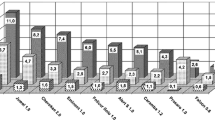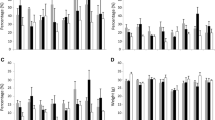Abstract
The correlation between the amount of deoxynivalenol (DON) and the percentage ofFusarium damaged kernels (FDK) in samples of wheat and triticale was studied.
Samples of naturally infected wheat grain, collected in 1986, 1987 and 1988 and of triticale collected in 1986 were used.
Additionally, artificial inoculated wheat samples (10 genotypes inoculated with 3F. Culmorum strains of weak, medium and severe pathogenicity and samples of 10 triticale genotypes inoculated withF. culmorum. andF. graminearun) were studied. Using statistical methods (the variance analysis, method of least significant difference (LSD), orthogonal contrast (OC) and minimum within groups sum of squares criterion (MSSC)), the samples were divided into two groups with respect to the attribute DON/FDK.
To the first group belong samples of wheat and triticale, of which the heads were artificially inoculated with severely pathogenic strainsF. culmorum. In the samples of this group the amount of DON in kernels damaged withFusarium increased by 0,46 mg/kg per 1% of FDK.
In the second group, consisting of naturally infected samples and samples from artificially inoculated heads the amount of DON increased 0,30 mg DON/kg per 1% of FDK.
The equation for the calculation of approximated amount of DON in farm and commercial lots of wheat and triticale after examination of percentage of FDK is given.
Similar content being viewed by others
References
Cheelkowski J, Visconti A, Perkowski J, Wakulirtski J, Botallico A (1988): Mycotoxins and fungi accompanying wheat head fusariosis in Poland. Mycotoxin Research, Special Edition, European Seminar “Fusarium — Mycotoxins Taxonomy, pathogenicity” Warsaw 1987, 57–60
Elandt R (1964): Statystyka matematyczna w zastosowaniu do doświadczalnictwa rolniczego. PWN, Warszawa
Gang L, Ying X, Zhang Z H, Fang CM, Li L (1988): Investigation of deoxynivalenol and zearalenone in wheat from Anhui province. Proceedings 7 th. International IUPAC Symposium on Mycotoxins and Phycotoxin, Tokyo, Japan, pp. 67–68
Gawęcki J, Wagner W (1984): Podstawy metodologii badań doświadczalnych w nauce o źywieniu i źywności. PWN, Warszawa — Poznań.
Gareis M, Bauer J, Enders C, Gedek B (1989): Contamination of cereals and feed withFusarium, mycotoxins in European coutries.Fusarium: Mycotoxins, Taxonomy and Pathogenicity. Ed. J. Chełkowski. Elsevier, pp. 441–472
Jelinek CF, Pohland AE, Wood G E (1989): Woldwide occurrence of mycotoxins in food and feeds — an update. J. Assoc. Off. Anal. Chem. 72: 223–230
Kiecana I.Perkowski J, Chełkowski J, Visconti A (1988): Trichothecene mycotoxins in kernels and head fusariosis susceptibility in winter triticale. Mycotoxin Research, Special Edition, European Seminar “Fusarium — Mycotoxins taxonomy, pathogenicity” Warsaw 1987, 53–56
Perkowski J, Chelkowski J, Wakulinski W. (1988): Deoxynivalenol and 3 acetyldeoxynivalenol andFusarium species in winter triticale. Mycotoxin Res. 4:97–1000
Perkowski J, Cheł kowski J, Wakuliński W. (1990): Mycotoxins in cereal grain. Part 13. Deoxynivalenol and 3 acetyldeoxynivalenol in wheat kernels and chaff head fusariosis symptom. Die Nahrung 34, 4, 325–328
Perkowski J, Wakul iński W, Chełkowski J (1990): Natural occurrence of deoksynivalenol 3 acetyl deoksynivalenol and zearalenone in wheat in 1988. — in preparation.
Shotwell OL, Bennett G A, Stubblefield RD, Shannon GM, Kwolek W F, Piatt n e r R D (1985): Deoxynivalenol in hard red winter wheat: relationship between toxin levels and factors that could be used in granding. J. Assoc. Off. Anal. Chem. 68: 954–957
Snijders CHA, Perkowski J (1990): Effects of head blight caused byFusarium, culmorum on toxin content and weight of wheat kernels. J. Phytopathology — in press.
Tanaka T, Hasegawa A, Yamamoto S, Lee U-S, Sugiera Y, Ueno Y (1988): Worldwide contamination of cereals by theFusarium mycotoxins nivalenol, deoxynivalenol and zearalenone. 1. Survey of 19 Countries. J. Agr. Food. Chem. 36: 979–983
Teich AH, Hamilton IR (1985): Effect of cultural practices, soil phosphorus, potassium and pH on the incidence ofFusarium head blight and deoxynivalenol levels in wheat. Appl. Environ. Microbiol. 49: 1429–1431
Teich AH, Shugar L, Smid A (1987): Soft white winter whead cultivar field — resistance to scab and deoxynivalenol accumulaton. Cer. res. Comm. 15: 109–114
Wang YZ, Miller JD (1988): Effects ofFusarium graminearum metabolites on wheat tissue in relation toFusarium head blight resistance. J. Phytopathology 122: 118–125
Author information
Authors and Affiliations
Rights and permissions
About this article
Cite this article
Perkowski, J., Chełkowski, J., Błażczak, P. et al. A study of the correlation between the amount of deoxynivalenol in grain of wheat and triticale and percentage ofFusarium damaged kernels. Mycotox Res 7 (Suppl 2), 102–114 (1991). https://doi.org/10.1007/BF03192194
Issue Date:
DOI: https://doi.org/10.1007/BF03192194




